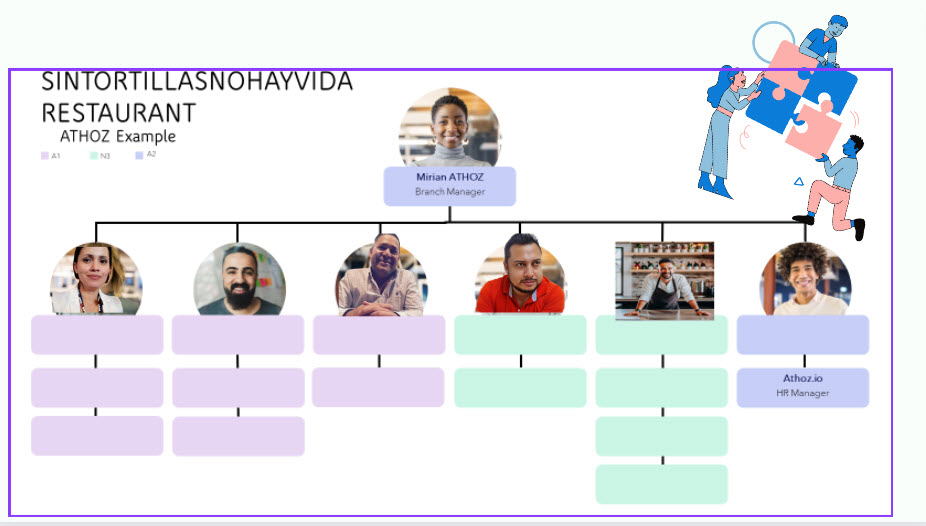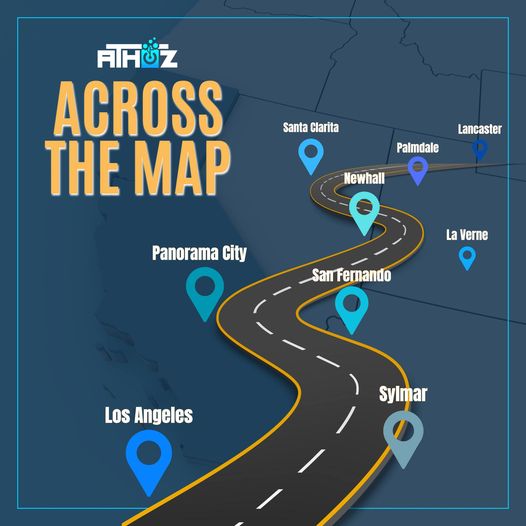Advantages of a Restaurant that works under an organizational structure of positions.
Roles, Human Resources and Processes.
The business structure of a restaurant can be diverse and will depend on its size, type, and management style. However, generally speaking, it is usually made up of management, customer service, kitchen, bar, human resources, and support functions. The even more structured ones have internal teams and may have updated processes and procedures in all areas, including marketing.

For a table service restaurant, it will be easy to detect the following areas.
If you want to expand your knowledge about this topic, we invite you to follow us on our social networks @athoz.io on Facebook and Instagram, where we will address this and other topics related to the business world.
A basic organizational structure for a table service restaurant is presented that includes: General Management, Customer Service Department, Service Staff, Kitchen, and Bar.
General Management is responsible for global management, strategic decision-making, and operations supervision. The Customer Service Department is directed by the Head of Room, who coordinates the service staff, and the Host/Hostess, who receives customers and assigns tables. The Service Staff is made up of Servers/Waiters who serve customers and Assistant Waiters/Busboys who provide general support. The Kitchen is directed by the Executive Chef and has Cooks and Kitchen Assistants who prepare food. The Bar is the area that prepares drinks, serves customers and maintains the inventory of liquor.
To have an effective organizational structure in a restaurant, it is important to define team communication and tasks according to what each area does. In the previous example, each job profile has basic requirements, skills, and knowledge of technology, leadership, problem-solving, empathy, customer service, and managerial skills. In addition, depending on the area, it may be necessary to have knowledge in more than one language and an attitude of continuous learning and organization to work as a team. The development of profiles will depend on the type of management decided to be implemented. In a future blog, we will explain step by step the creation of a job profile.

A restaurant that works with a clear structure of positions and roles tends to experience benefits in terms of organization, operational efficiency, staff development, customer experience, performance management, work environment and adaptability.
These benefits contribute to a smoother and more successful operation compared to a restaurant that lacks this structure.
| Aspect | Restaurant with Position and Role Structure | Restaurant without Structure of Positions and Roles |
| Customer experience | – Defined roles contribute to more consistent customer service. – Well-trained staff in their duties improves the customer experience. | Possibility of variability in the quality of customer service. – Lack of specialization in specific tasks. |
| Performance management | More accurate assessment of individual performance based on specific responsibilities. – Facilitates the identification of areas for improvement. | Difficulty evaluating performance without clear roles and responsibilities. – Less specific and constructive feedback. |
| Working environment | – Defined roles reduce ambiguity and promote a more positive work environment. Less probability of internal conflicts due to lack of clarity in functions. | Possible frustration among employees due to lack of structure. – Greater risk of work tensions. |
| Adaptability and Scalability | Facilitates the incorporation of new employees through job profiles. – Structure that can be scaled with the growth of the restaurant. | – Greater difficulty in integrating new employees efficiently. Less ability to adapt to changes in size or operation. |

| Aspect | Restaurant with Position and Role Structure | Restaurant without Structure of Positions and Roles |
| Organization and Efficiency | Clarity in the responsibilities of each employee. -Efficient distribution of tasks. Lower risk of overlapping functions. | Confusion regarding the responsibilities of each employee. Possibility of duplication or missing key tasks. Greater probability of internal conflicts. |
| Personal development | Job profiles make it easy to identify development opportunities. – Training programs adapted to specific roles. | – Lack of clear direction for skill development. – Less focus on individual employee growth. |
A restaurant must comply with federal and state labor laws and regulations, administer compensation and benefits programs, foster a positive work environment, ensure workplace safety, and maintain accurate human resource management records. All of this is essential to avoid regulatory problems and to create an optimal environment. For more related topics, in future installments.
@athoz.io on Instagram/Facebook.
We’re dreamers at heart, always pushing the boundaries of what’s possible. With creativity and hard work, we ignite the fires of progress and weave magic into everything we do. Our technology is the ultimate sidekick, helping our partners to achieve greatness and success. Witnessing their victories fills us with a sense of accomplishment that can’t be beat!
Team Athoz.


